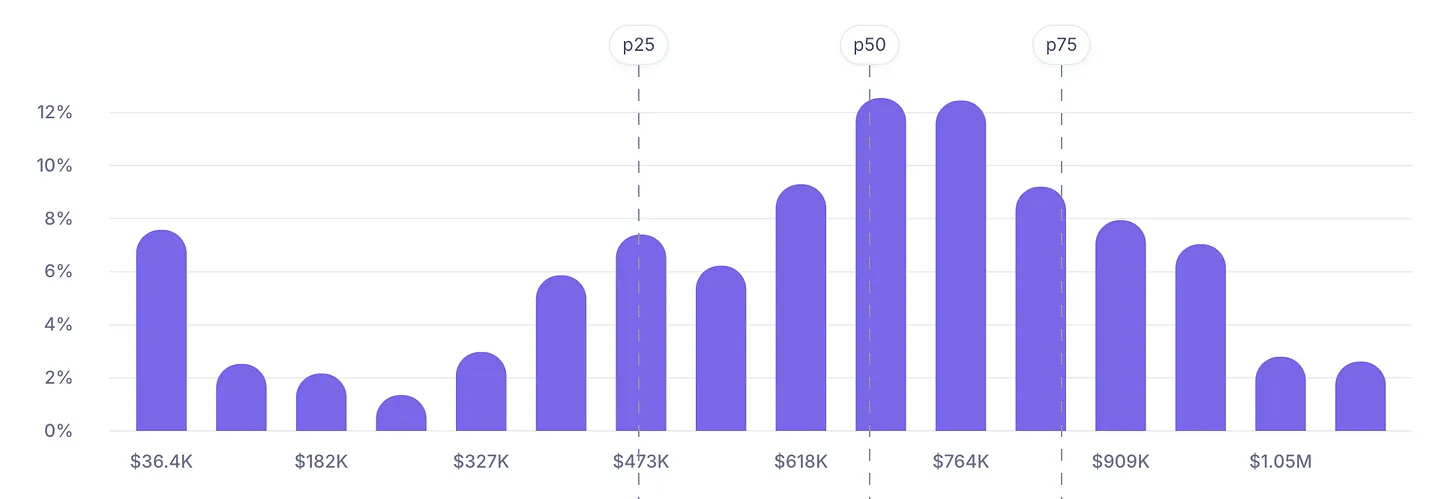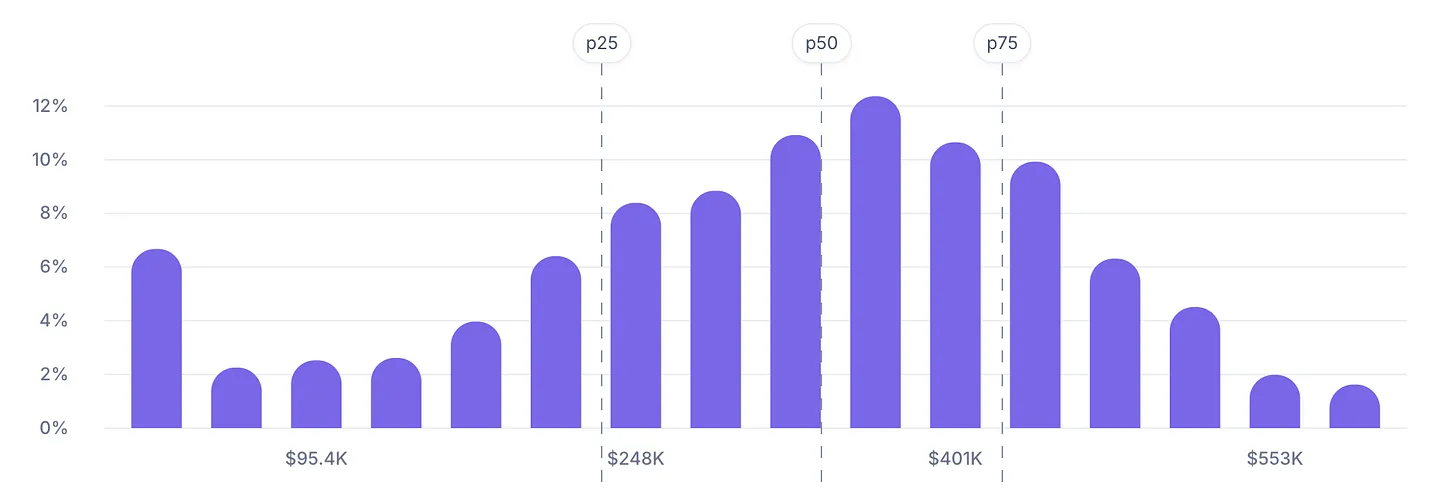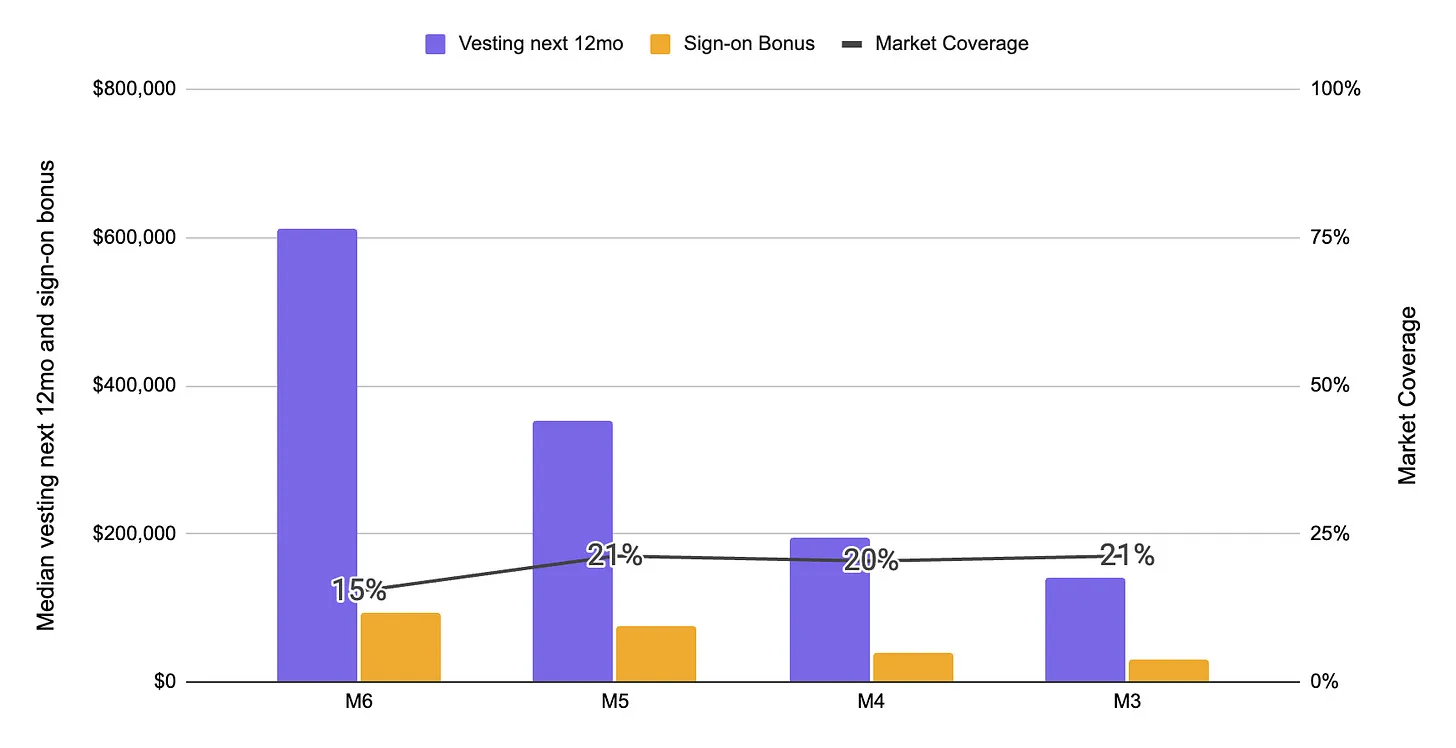Key topics
When a candidate tells you she has $1,000,000 in unvested equity value, should you pay everything to make her whole?
No, probably not.
Developing a smart and compelling offer involves building out four-year cash flow scenarios. It’s a fun model — shoutout Matt Olson for teaching me how to do this thirteen years ago.
But unless the candidate volunteers a detailed and accurate picture of that $1m walkaway value (you can’t ask!), you are stuck with using a lot of weak assumptions and spotty information… right?
It turns out market data in Compa can give you excellent information to:
- Validate what the candidate shared,
- estimate walkaway details, and
- develop a winning offer without overpaying.
Here’s how to do it.
Check market unvested equity values
First, the $1m unvested value looks steep:

This is the market total unvested value for M5 Software Engineering in Compa, calculated using current value from all grants for current employees based on grant-level market data from stock admin systems.
- Median is $715k
- 75th is $901k
- The candidate’s reported $1m is at the ~90th percentile
So we have validated that $1m walkaway looks high.
One possibility is the candidate is embellishing a tad, and based on my experience this is common. (“Well, if our stock keeps going up it will be $1m by the end of the year.”) Another way to think about it is it’s very unlikely a competitor would pay the full amount.
Break down the walkaway value timing
How much of that $1m vests this year? In future years?
When you build your four-year cash flow model, you can “pay” for some of the unvested value through both your new hire grant and future refresh grants. But the candidate’s objection will be that she has to wait for the new grants to vest, leaving a gap this year.
So let’s go back to the market data in Compa and toggle from Total Unvested to Vesting next 12mo:

A much different picture emerges:
- Median is $353k
- 75th is $445k
- The candidate’s 90th percentile reported value is ~$500k
With this market information, we can infer that about 50% of walkaway value vests in the next 12 months.
Interestingly, we can substantiate this ratio as a good rule of thumb looking across other levels:

Also, this makes sense based on typical NH:Refresh grant ratios (2.5 for more senior M levels) and how grants stack up.
Take an employee with three years of tenure and annual refresh grants:

The higher new hire grant final vest props up the unvested value vesting over the next 12 months.
Subscribe
How much does the market cover?
Now my favorite part — how much does the market cover walkway value in the first gap year?
Most companies use a 1-year cliff in their new hire grant schedules (although we’re seeing some companies ditch it in their refresh grants) to make sure the employee sticks around for the first year.
This creates a gap:
- Our candidate will vest ~$500k over the next 12 months
- Our stock comp pays nothing over the next 12 months
So this is where we use a sign-on bonus. Do we have to pay the whole $500k to get the offer accepted?
Again, we can turn to market data to estimate how much gap the market covers. And this is my favorite because it combines two types of market data in Compa, offers-based and grants-based, to compare sign-on bonuses and unvested equity.
Here’s what we find:

The market only covers 20% of the value vesting over the next 12 months.
That is, your candidate can expect to take an 80% hit on first year cash flow to take the new job; in our example, that’s $400k.
From the employer perspective, a $100,000 sign-on bonus covers $1,000,000 in total walkaway value, about half of which likely vests over the next 12 months.
Why does a candidate accept this? And how do you sell it?
Tell your story:
- Better base and bonus target
- Our stock price is growing and yours is declining
- Bigger role, better manager, exciting vision
- While the employer pays a sign-on bonus to unseat the candidate, the candidate pays a larger opportunity cost to join the new company
One more thing
Compalluminati last week was incredible!
300+ comp leaders from the world’s best companies gathered at DoorDash HQ in San Francisco to discuss the future of comp. Products were announced, Compallumilattes were served, and a sweet Compa truck took to the streets of SoMa:

Thank you to my team for organizing, DoorDash for hosting, and to everyone who joined us!
We love bringing this special community together.

.svg)

.webp)
.webp)
.webp)
